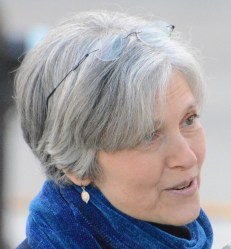
Jill Stein, the Green Party’s presumptive presidential nominee.
The Green Party came cruising into Baltimore on Thursday — er, wait, came riding into Baltimore. No. Had party members been able to walk and ride bicycles into Baltimore, I’m sure they would have, but even presumptive presidential nominee Jill Stein found herself riding in a jumbo jet in order to get here in a timely fashion.
But they made it nonetheless, and here they’ll stay for the next three days, holding workshops, fundraisers, and nominating their candidate for the highest office in the land. Barring any magical Roseanne Barr love-fest tomorrow at the nominating convention (the former sitcom star also tossed her hat in the ring), it will be Stein’s name on the ballot in, more than likely, 45 states by November.
In some ways it seems fitting that the Green Party chose Charm City as the location for its presidential nominating convention. Baltimore is sometimes forgotten to its bigger cousins, Washington, D.C., and New York City. It’s often seen as quirky and eccentric. And it’s easily stereotyped by the images we see in popular culture. (No, not every block is straight out of The Wire.)
Welcome to the Green Party, hanging on the heels of the Republican and Democrat parties, populated by an array of disparate interest groups, and written off by state election boards as unserious, tree-hugging, dove-releasing, organic-farming, grass-fed beef-ing … you get the point.
Stein, a Boston physician who was inspired to take up politics by environmental health epidemics, is perhaps a more mainstream candidate than the party has put forward in recent years. But still, it seems that nary a story can pass through the national media without the specter of her most prominent predecessor hanging overhead. Here’s the Times, yesterday:
While Ms. Stein barely registers a blip in national polling, experts point to Ralph Nader, the Green Party nominee in 2000, who was seen by many Democrats as siphoning just enough votes from Al Gore in one state, Florida, to tip the election to the Republican, George W. Bush. Nationally, Mr. Nader had captured only 3 percent of the vote.
Could such a situation unfold again?
Stein brushes off these fears. “We have 10 years of experience with muzzling ourselves politically, and it’s very clear now that silence has not been an effective political strategy,” she said in an interview with Grist earlier this year. “The politics of fear in fact has delivered all those things that we were afraid of.”
“The challenge for us is overcoming conventional communications, which is corporate-sponsored and would like to keep us down and out,” Stein told me in an interview Thursday night. “The political system is very engineered to silence any opposition party that’s not the corporate-controlled, big Wall Street power.”
Certainly the Green Party has made strides. For the first time in its 11-year existence, it has qualified for matching funds from the feds, up to donations of $250. Spirits have been buoyed by the Occupy movement that exploded onto the national media scene last fall, which was, to a large degree, a physical embodiment of the political philosophy of Greens: health care for all, forgiveness of college student debt, employment for everyone, an emphasis on environmentalism and green jobs, a reformed pathway to citizenship for illegal immigrants. Oh, and, legal weed.
“Everybody’s worried about a job, paying their college debt,” said Stein, who chose anti-poverty advocate Cheri Honkala to be her vice-presidential running mate. “This movement is vibrant and strong and unstoppable.”
Stein believes many people agree with Greens, and doesn’t understand, for instance, why banks get bailed out and students don’t. “A political campaign provides another rallying point for this very pent-up, frustrated energy that we can do better and the current system isn’t providing it,” she says. “It’s like a pressure-cooker now, and it needs an outlet.”
Whether that outlet is the Green Party, and whether people will be willing to cast their votes for Stein with the ghost of Ralph Nader – and the very real Mitt Romney — lurking about, remains to be seen. Perhaps, at the very least, her presence will prod President Obama to pay a little more heed to members of his “base” who might be tempted to jump ship. (In the last month, Obama has skipped both the Earth Summit and the national convention of the NAACP.)
This weekend in Baltimore may offer some hints as to what the coming months hold. The Greens have been hosting a series of workshops these first two days, about the Green New Deal, the green economy, and how to get money out of politics. Tonight they’ll throw a fundraiser at an art gallery and music venue in the city’s Station North arts and entertainment district. (Cover charge: $20.) Tomorrow will bring a string of speeches from national thinkers and activists, including 2008 vice-presidential nominee Rosa Clemente, and nominating speeches from Stein and Barr.
The turnout thus far would make anyone look askance at setting up more than two rows of chairs in a tiny press room, but organizers say there are 250 registered delegates, and expect up to 400 people to attend the convention.
As to why the Green Party picked Baltimore, Stein assured me that “a lot of thought” went into the decision. Something about a strong Green Party in the city. But if it’s here, it’s well hidden — or perhaps it’s just composed mostly of photosynthesis-loving organisms. The Maryland State Board of Elections revoked the party’s space on the state ballot last year because the Greens had failed to win 1 percent of the vote in the most recent election. Party members are now trying to collect the 3,000 signatures required to get back on the ballot.
Where are all those occupiers when you need them?



